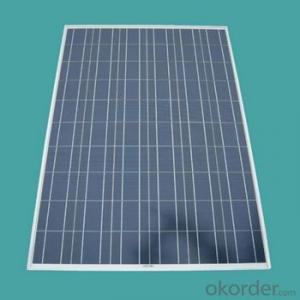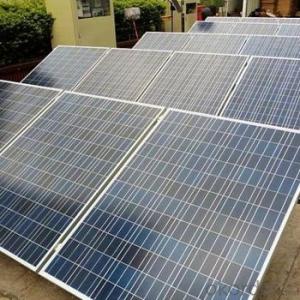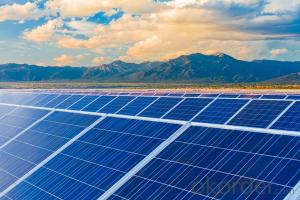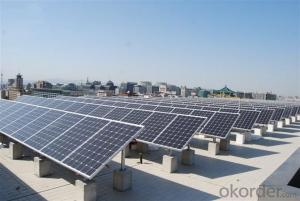Solar Polycrystalline Panels Max Power 240-W
- Loading Port:
- Shanghai
- Payment Terms:
- TT OR LC
- Min Order Qty:
- 100 pc
- Supply Capability:
- 30000 pc/month
OKorder Service Pledge
OKorder Financial Service
You Might Also Like
Product Description:
Solar Polycrystalline Series
Our designing philosophy is making solar product easy to use and convenient to maintain. We adhere to "develop inverter and controller" as our core technology, and built up solar product from 0.5W to 100KW into standard and mass production, meeting most customers' needs in this field.
Product Name : 240W solar panels
Max Power(W) : 240W-36P
Dimension(mm) : 1960*986*50 (mm)
Weight(kg) : 23.5 (kg)
Max Current(A) : 6.94 (A)
Max Voltage(V) : 36 (V)
Short Circuit Current(A) : 7.78 (A)
Open Circuit Voltage(V) : 43.2 (V)
Number of Cell (PCS) : 6*12 (PCS)
Contrast with other model solar panels
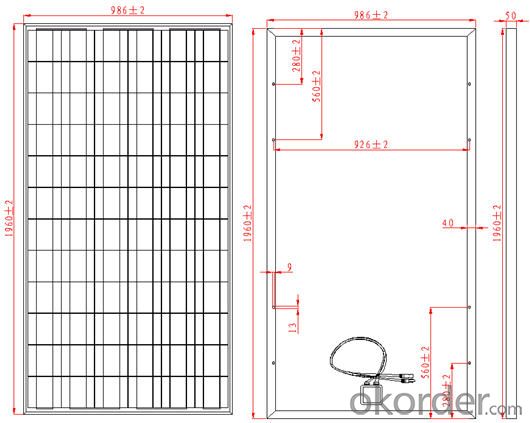
ITEM NO. | ESC280W-36P | ESC270W-36P | ESC250W-36P |
Maximum Power (W) | 280 | 270 | 250 |
Optimum Power Voltage (V mp) | 35.14 | 35.14 | 35.14 |
Optimum Operating Current (I mp): | 7.97 | 7.69 | 7.12 |
Open Circuit Voltage (Voc) | 43.2 | 43.2 | 43.2 |
Short Circuit Current (ISC) | 8.53 | 8.21 | 7.6 |
Cell Efficiency (%) | 16.00% | 15.40% | 14.27% |
Module Efficiency (%) | 14.49% | 13.97% | 12.94% |
FF (%) | 70-76% | ||
Warranty | 90% of 10 years, 80% of 25 years. | ||
Standard Test Conditions | AM1.5 1000W/m225 +/-2ºC | ||
Bypass Diode Rating (A) | 12 | ||
Cable & Connector Type | Pass the TUV Certificate | ||
Brand Name of Solar Cells | ----Cell | ||
Size of Module (mm) | 1960*986*50 | ||
Solar Cell | 156*156Poly | ||
Backing (Material) | TPT | ||
Frame (Material Corners, etc.) | Aluminum-alloy | ||
Number of Cell (PCS) | 6*12 | ||
N/W(KG) | 20.96 | ||
Junction Box Type | Pass the TUV Certificate | ||
Tolerance Wattage (e.g. + /-5%) | +3% | ||
Front Glass Thickness (mm) | 3.2 | ||
Surface Maximum Load Capacity | 2400Pa | ||
Allowable Hail Load | 23m/s, 7.53g | ||
Packing | 1*20' | 226pcs | |
1*40'STD | 460pcs | ||
Temperature Coefficients of ISC(%)ºC: | 0.04 | ||
Temperature Coefficients of Voc(%)ºC: | -0.38 | ||
Temperature Coefficients of Pm(%)ºC: | -0.47 | ||
Temperature Coefficients of IM(%)ºC: | 0.04 | ||
Temperature Coefficients of VM(%)ºC: | -0.38 | ||
Temperature Range | -40ºC to +85 | ||

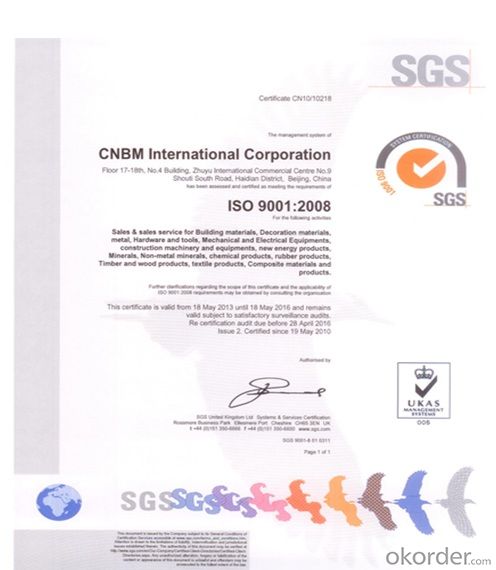

FAQ
We have organized several common questions for our clients,may help you sincerely:
①What price for each watt?
It depends on the quantity, delivery date and payment terms,
②What is your size for each module? Can you tell me the Parameter of your module?
We have different series of panels in different output, both c-Si and a-Si. Please take the specification sheet for your reference.
③Can you provide the peripheral products of the solar panels, such as the battery, controller, and inverter? If so, can you tell me how do they match each other?
Yes, we can, we have two companies for solar region, one is CNBM International, the other is CNBM engineering Co.
We can provide you not only the solar module but also the off grid solar system, we can also provide you service with on grid plant.
④What is your warranty system?
Our product performance guarantees for 25 years
• 12 years guarantee for workmanship
• Timeliness of delivery
• Quality Products certified (TÜV, UL, CE, ISO)
⑤How do you pack your products?
We have rich experience on how to pack the panels to make sure the safety on shipment when it arrives at the destination.
⑥ Can you do OEM for us?
Yes, we can.
⑦How long can we receive the product after purchase?
In the purchase of product within three working days, We will arrange the factory delivery as soon as possible. The pecific time of receiving is related to the state and position of customers.Commonly 7 to 10 working days can be served.
- Q:Can we cover up solar panels on our house with regular siding?
- oh my goodness. make the investment aand update them
- Q:I own a townhome in the Phoenix area (my power company's SRP, if that makes a difference). Phoenix is a great place for solar. I could probably save money, in the long term, if I got some solar panels.But I am currently extremely broke, so I can't buy solar panels unless I will more or less immediately be paying no more than I am now per month, with little or nothing down. And most of the solar leasing places won't work with me, because (as is common for townhomes) I don't technically own my roof. I have permission to put things on it, but the property management people (or whoever actually owns my roof) won't sign the lease or whatever.Anyone know of either a way to buy solar panels without paying significantly more per month than I already do for electricity, or a solar leasing company that can work with the restrictions I have?
- There are companies who would install solar panels on your roof for no cost. The catch is that they get the power generated for the first 20 years which is the useful life of the panels then you get what's left of the obsolete panels, meanwhile you're required to purchase your power from them at allegedly reduced rates but there is no guarantee that they would remain reduced versus the market once they have you locked in. It's like how the cell phone companies will give you a free cell phone if you sign a contract. Keep in mind that once you've factored in the installation costs and the useful life of the panels, the effective costs of solar photovoltaic energy is about 23 cents to 43 cents a kwh while grid power is about 5 cents per kwh to the consumer, 3 cents per kwh to the utilities for coal generation. It's just that so few people understand how to project an initial capital expense with periodic future returns through discounted cash flow, hence people think solar power is free out of ignorance. Without government incentives, there are no economic benefits to solar and most solar installers structure the sales such that they gain the economic benefit instead of the consumer who is often ignorant of how to calculate the financials.
- Q:Can solar panels be installed in areas with high winds?
- Yes, solar panels can be installed in areas with high winds. However, it is crucial to consider the design, installation, and maintenance of the solar panel system to ensure its durability and stability in such conditions. Reinforcements and proper anchoring techniques can be employed to withstand the wind load and prevent any damage to the panels.
- Q:I need to build a battery array to use with my solar panels I just bought. I want to be able to store enough energy to be draw from it at night, possibly around the clock. Is there a down side to using the deep cycle battery I bought from autozone and 6 or 7 more just like it, or do I need to get some other battery?
- There are batteries particularly made for solar, such as the Trojan T05-RE . I think the RE stands for renewable energy. A deep cycle battery should work all right, although not quite as well. What you want to do is try out your setup first, with just one battery, and the panels provided. If this is one of those 45 watt kits, you may be surprised at how little energy you actually get from the panels. Increasing the number of batteries won't help, either - that's like getting a larger water tank, when you only have a trickle to fill it. If your goal is really to save money, the most cost-effective solar is the grid-tied type, with no batteries at all. That's what we have, and I've never regretted it.
- Q:Can solar panels be used during a power outage?
- No, solar panels cannot be used during a power outage unless there is a battery backup system in place.
- Q:How much electricity does a solar panel produce?
- The amount of electricity a solar panel produces depends on various factors such as its size, efficiency, location, and weather conditions. On average, a typical residential solar panel can produce anywhere between 250 to 400 watts of electricity per hour.
- Q:Home depot has solar panels but they are so expensive? were is the best place to get them?
- Best okorder /... Of course sometimes you can get very cheap solar panels if you are in the right place at the right time... A friend of mine got the solar array from one of the road service companies... it had some minor defect so they were replacing it and throwing away the defective one... it still put out a good bit of power and it was free for him... but that is all luck.
- Q:Can solar panels be used to power a factory?
- Yes, solar panels can be used to power a factory. By installing a large number of solar panels on the factory's roof or in nearby open spaces, the generated solar energy can be harnessed and converted into electricity to meet the power requirements of the factory. This can help reduce the dependency on traditional grid electricity and also contribute towards a more sustainable and environmentally friendly operation of the factory.
- Q:How much space do I need for solar panels?
- The amount of space required for solar panels depends on various factors such as the size and type of panels, the efficiency of the panels, and the energy needs of your household or facility. On average, a 1 kW solar panel system typically requires around 100 square feet of space. However, it is best to consult with a solar installer or expert who can assess your specific requirements and provide accurate information regarding the space needed for solar panels.
- Q:I need to reduce the average monthly home electricity bill by powering some of the household appliances using solar panels. Can I use a 250 watt solar panel to power a medium sized upright fridge?
- Solar panel alone? No. With the appropriate storage system and inverter, perhaps. You will need to do the calculation - as follows: In a solar day that averages about eight hours, you will generate about 67% of your rated output over those 8 hours. That means you will have made 340 watts. Your refrigerator will run for about four (4) hours per day on average if you are very careful about opening and closing. If you have a 400-watt (average-when-running) fridge, you will have a small cushion that will be absorbed by inverter losses, charger losses and so forth. So, with an adequate set of storage batteries, a good charger and a good inverter, you just might be able to operate that small fridge. No icemaker, no other power drains. But, two 250-watt panels would be better.
1. Manufacturer Overview |
|
|---|---|
| Location | |
| Year Established | |
| Annual Output Value | |
| Main Markets | |
| Company Certifications | |
2. Manufacturer Certificates |
|
|---|---|
| a) Certification Name | |
| Range | |
| Reference | |
| Validity Period | |
3. Manufacturer Capability |
|
|---|---|
| a)Trade Capacity | |
| Nearest Port | |
| Export Percentage | |
| No.of Employees in Trade Department | |
| Language Spoken: | |
| b)Factory Information | |
| Factory Size: | |
| No. of Production Lines | |
| Contract Manufacturing | |
| Product Price Range | |
Send your message to us
Solar Polycrystalline Panels Max Power 240-W
- Loading Port:
- Shanghai
- Payment Terms:
- TT OR LC
- Min Order Qty:
- 100 pc
- Supply Capability:
- 30000 pc/month
OKorder Service Pledge
OKorder Financial Service
Similar products
New products
Hot products
Hot Searches
Related keywords
